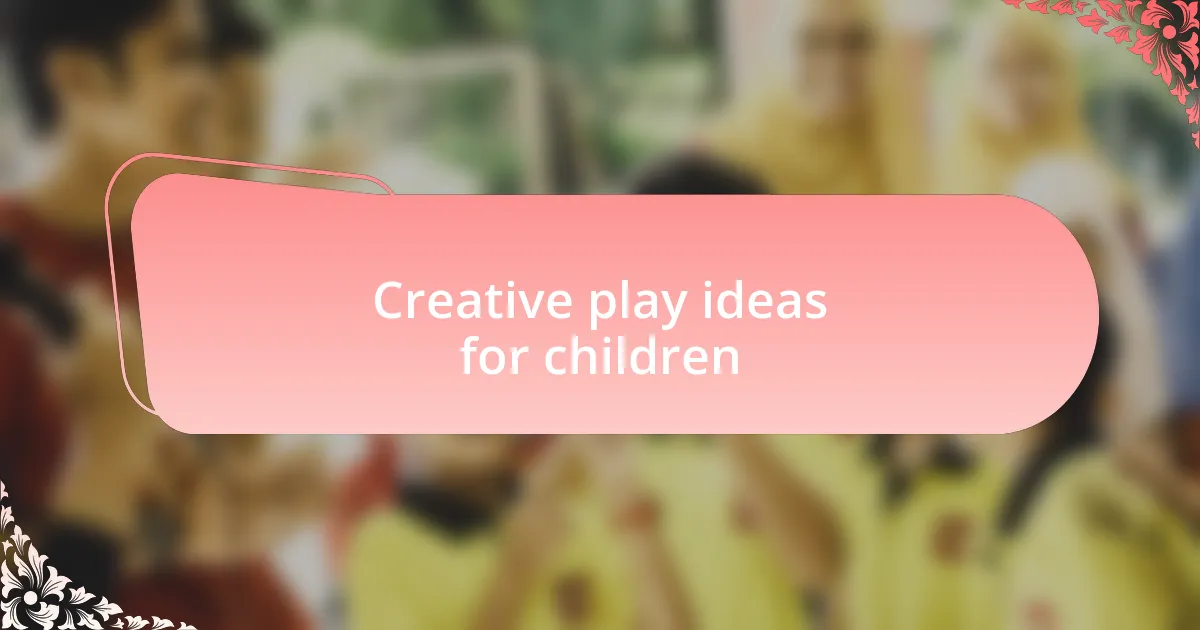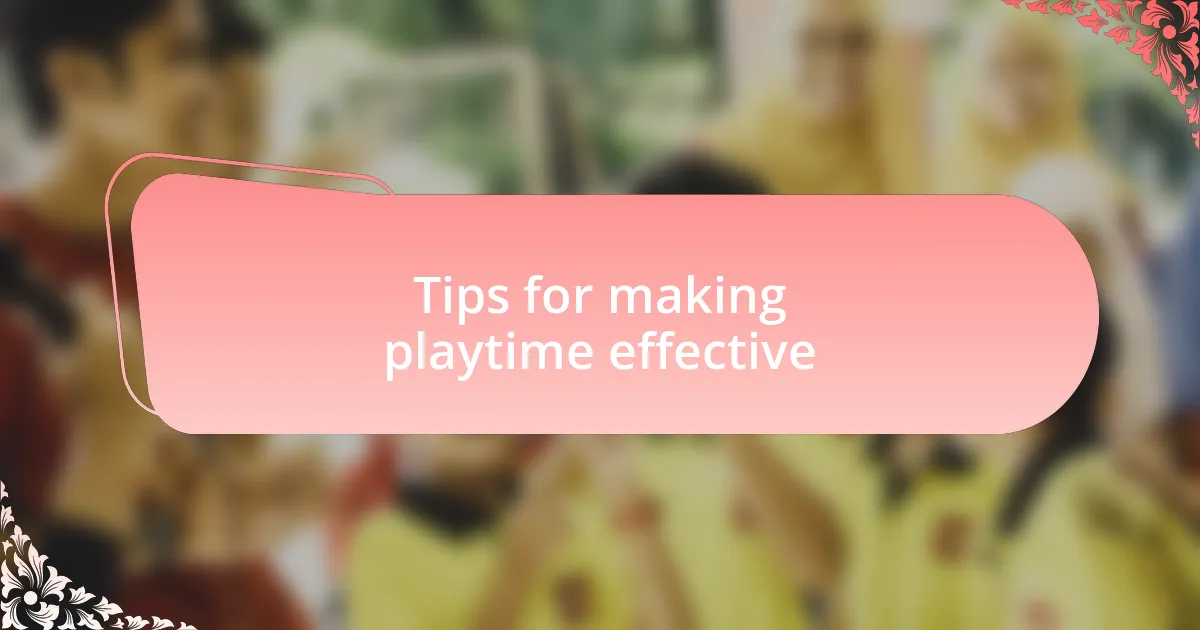Key takeaways:
- Child health support involves understanding the unique needs of each child, balancing play and structured learning to promote overall well-being.
- Play fosters creativity, emotional expression, and social skills, serving as an essential tool for cognitive development and resilience.
- Incorporating play into daily routines enhances quality time and makes ordinary activities more engaging, which strengthens family bonds.
- Creative play ideas and effective playtime strategies, such as integrating learning elements and encouraging free play, are crucial for supporting independence and imaginative growth.

Understanding child health support
Child health support is all about understanding the unique needs of children as they grow and develop. I often reflect on my own experiences watching my kids navigate early milestones. It makes me realize that a supportive environment can significantly influence their physical, emotional, and social well-being.
One fascinating aspect of child health support is the balance between play and structured learning. I remember a time when my daughter, after a long bout of illness, started to engage with her toys again. That simple act of play seemed to uplift her spirit and boost her recovery. Isn’t it incredible how playtime can serve as both a healing tool and a way to encourage healthy development?
Moreover, recognizing that every child is different is essential in providing effective health support. There are moments when I notice how my son is more stressed during school assignments and requires a different kind of attention. How do we, as caregivers, adapt to these variations? By actively listening and being present, I strive to offer tailored support that meets my children’s emotional and physical needs, fostering a healthier overall environment.

Importance of play in childhood
Play is an essential component of childhood that fosters creativity and imagination. I often find that when my kids engage in unstructured play, they invent entire worlds, which not only entertains them but also enhances their problem-solving skills. Have you ever noticed how a simple cardboard box can transform into anything from a spaceship to a fort? This imaginative play truly nurtures their cognitive development.
Furthermore, play provides a safe space for children to express their emotions. I’ve seen my youngest process feelings of frustration during a game, using the activity as a way to navigate her emotions. This kind of emotional exploration is invaluable, as it lays the foundation for healthy expression later in life. Isn’t it fascinating how the act of playing can help our children understand and manage their feelings?
Social skills are another significant benefit of play. I vividly remember a playdate where my kids had to negotiate their roles in a game. Watching them collaborate, share ideas, and even resolve conflicts in a playful context made me appreciate how these interactions build their ability to relate to others. Isn’t play truly a masterclass in social learning, showing children the importance of teamwork and empathy?

Benefits of incorporating play
Incorporating play into my routine has a profound impact on my children’s physical health. I remember a sunny afternoon when we turned our backyard into an obstacle course. As they climbed, jumped, and ran, I couldn’t help but marvel at how much their laughter filled the air. This active play not only kept them fit but also boosted their mood, literally making them happier and more energetic throughout the day. Doesn’t it amaze you how such simple activities can contribute to overall well-being?
On another note, play enhances learning in a way that traditional classroom settings sometimes cannot. I’ve observed my kids grasp complex concepts through playful learning, like when we used building blocks to explore basic math. Suddenly, numbers came to life! This hands-on experience ignited their curiosity and retention. Can you think of a time when your child learned something new just by having fun? It’s magical how play can bridge the gap between playtime and educational growth.
Moreover, the spontaneity of play often deepens my children’s resilience. I recall a day when my daughter fell while riding her bike. Instead of succumbing to frustration, she got up, laughed, and tried again. Witnessing her bounce back, I realized that these moments of play teach them perseverance and grit. Don’t you find it inspiring how a simple game of tag can instill such important life lessons?

Daily routines that include play
Daily routines that seamlessly incorporate play can transform ordinary moments into lively adventures. For instance, every morning, I let my kids know that breakfast is not just about eating; it’s also about becoming “taste testers.” They actually get excited about trying different fruits, turning a mundane meal into a playful challenge. Have you ever considered how making meals interactive can spark joy and creativity in your children?
In the afternoons, we have a dedicated “dance break” that I absolutely love. It’s a simple ritual: we stop whatever we’re doing and just dance to our favorite songs for ten minutes. This little burst of movement not only helps alleviate stress but also elicits genuine giggles as we bust out our most ridiculous moves. Isn’t it refreshing to see them completely lose themselves in joy, even for a few moments?
I also make time for outdoor explorations during our evenings. Whether it’s a spontaneous walk to the park or a leisurely bike ride around the neighborhood, I always encourage playfulness on our pathways. I remember one particular evening when we found a puddle and ended up jumping in it together. The laughter that ensued was priceless, and it made me realize that these moments of unhindered play can greatly enhance our connection. How often do we allow ourselves to embrace the fun in everyday activities?

Creative play ideas for children
One of my favorite creative play ideas is turning ordinary craft supplies into imaginative treasures. The other day, I gathered some paper plates, markers, and leftover fabric scraps to create “mystery masks.” My kids loved the challenge of designing masks that represented different characters, and watching their creativity unfold filled me with joy. Have you ever noticed how a simple stack of materials can become a springboard for their imaginations?
We also enjoy themed scavenger hunts right in our backyard or even indoors. I remember organizing a “color hunt” where we searched for objects that matched a specific color. It was exhilarating to see their eyes light up as they discovered items I would have never thought to include, like a shiny blue marble or a bright red toy car. Isn’t it fascinating how adventure can find us in the most familiar of places?
Another favorite is storytelling through movement. On days when we have a bit of extra time, I set up a space for “story dance,” where we physically act out a story together. I recall one instance where we transformed into animals from our favorite book, hopping like frogs or fluttering like butterflies around the living room. Those moments not only foster physical play but also strengthen our bond. Isn’t it magical how dance can communicate emotions that words sometimes can’t?

Tips for making playtime effective
When it comes to making playtime effective, I find that incorporating a simple routine can set the stage for meaningful engagement. For instance, I designate specific times throughout the week as “play dates” with my children, creating an expectation that play is a priority in our lives. There’s something magical about knowing that playtime is coming—it’s like a little countdown to joy. How often do we set aside time just for fun in our busy schedules?
Another tip I have is to blend educational elements into play. Recently, I introduced a cooking day where we not only made a delicious pizza but also practiced measuring ingredients. Seeing my kids realize that math can be part of something so enjoyable was a win-win moment. Have you ever noticed how learning through play makes concepts stick better?
Lastly, I always encourage free play without too much direction. One weekend, I set up a DIY fort-making challenge using pillows and blankets, allowing the kids to take the lead in deciding the design and rules. It reminded me how important it is for children to express their ideas and solve problems on their own. Isn’t it incredible how play can foster independence and creativity at the same time?

Personal experiences with play integration
Integrating play into my routine has always felt natural, especially during family gatherings. I vividly recall a summer picnic where everyone, from grandparents to toddlers, joined in a spontaneous game of sack races. The laughter that erupted filled the air and created lasting memories; isn’t it wonderful how play can bridge generational gaps?
I also cherish our nature walks, which have become a playful exploration of our surroundings. One day, while hiking, I turned a simple observation into a game by asking the kids to find specific leaves or animal tracks. The excitement in their voices, as they rushed to identify each find, was priceless. Have you ever seen kids transform curiosity into joy through play?
Sometimes, I lean on technology to enrich our playtime. A while back, I discovered a dance app that turned our living room into a mini dance-off arena. The kids and I laughed, stumbled, and danced like nobody was watching. It struck me that play doesn’t have to be traditional; it can evolve with our lives and still create those joyful moments we all crave.